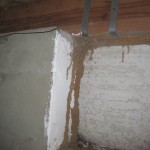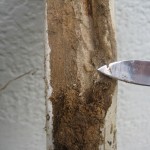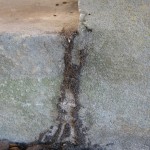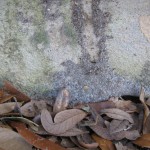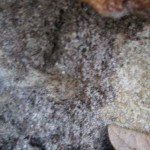Do ants make tunnels like termites?
It’s a common question and even some exterminators too quick to respond will answer incorrectly. Ants DO make above ground tunnels in which they travel and I suppose it provides them some protection. Many termite jobs have been sold to unaware homeowners by misinformed pest control salesman and I’m sure a few by those who did know but took advantage. Ant tunnels are not as common as termite and with a quick look on the internet one might say they do indeed have termites and be all to willing to get a job done to save their home from damage. There are a few differences in the tunnels and in just a few minutes you’ll be able to tell which is which and hopefully save you from wasting money on a pest you may not have.
Let’s look at termite tunnels
Termites are blind and shun light so a tunnel not only keeps them in
preferred darkness but also prevents them from getting lost. Termite tunnels are made by worker termites placing tiny grains of sand or dirt to form a tunnel and securing the particles with their saliva and fecal matter. The mix creates a slurry and the tunnels can range from pencil thickness which allows two way traffic to a full blown super highway that can sometimes be 10 inches across. When dry the tunnels give them great protection from enemies such as
ants and should a break occur the damage is quickly repaired and any would be invader gets met by the termite soldier and his powerful pinchers. I’ve seen tunnels extend 30 feet or more up or along a wall and even free standing tunnels that go from the wood source straight to the ground with no support. When you scrape a termite tunnel off a wall you will see the outline left behind that is very difficult to remove. This is the dried slurry and more fecal matter which gets thicker as the tunnel ages and expands with construction. When the tunnel is really large the outline(sometimes referred to as etching or shadow) will be a much lighter color presumably from the heavy non stop traffic. Termites are industrious hard workers but seldom pass up a chance to construct these pathways in a seam like where two 2×4’s are side by side. The reason is that 2/3’s of the tunnel is pre built and they need only to seal off the joint between the boards. There is no surface that I know of that is immune to termite tunnels and I’ve seen them on porcelain bathtubs to tire treads.
Ant tunnels
Ant tunnels are usually not very elaborate and rarely go more than 6 to 8 inches high. Ants do not create any material to cement the
passage so it is sort of like a Jenga stack and any direct disturbance may mean the whole thing collapses. I’m not sure why ants build these tunnels because they have fully functioning eyes and use pheromone trails to to get from point A to B. Perhaps it is some sort of disguise that they use so in that way it would protect them but these fragile structures easily fall apart with the slightest touch so that is about all I can figure. You will find these tunnels in seams at times usually in sheds or unfinished garages but generally I see them extending from the soil up to and under the homes siding or veneer. Since there is no sticky material the tunnels are usually only found on rough course surfaces such as bricks or cement foundations.
Do all ants make these tunnels?
The two types of ants I know of that have this behavior are the Big Headed Ant and the fire ant. There may be more but even the subject of above ground ant tunnels is not found in any reference I checked. While the BHA build the type of tunnel I’ve described fire ants only ‘technically’ may have a tunnel on your home. It is actually their mound and the cavities inside that may extend under the siding or inside the structure. Fire ants are famous for this at garage door jams or where siding or stucco is only a few inches from the ground. In fact fire ant mounds are built entirely using this Jenga method. Balancing millions of particles of sand they create elaborate mounds with tunnels and chambers that often get destroyed by a curious kid or passing lawnmower. Fire ant mounds do gain strength from rain when they dry but are still just a kick away from collapsing.
I wish I could tell you more about these mysterious tunnels that seem to have no real purpose but I just don’t know. Perhaps someone
reading this blog will have the answer and share it with us. I do know that if you have a termite infestation you want to get rid of it effectively and as quick as possible. Termite work can run in the thousands of dollars while ant work rarely gets that high. Knowing the difference between an ant and termite tunnel could save you from a needless messy termite job and keep more money in your wallet. Now with all that money you saved there is no reason you can’t afford to sign up for the RSS feed on my site and your spouse will be so happy when they hear of where the money went, it’s a win win!

